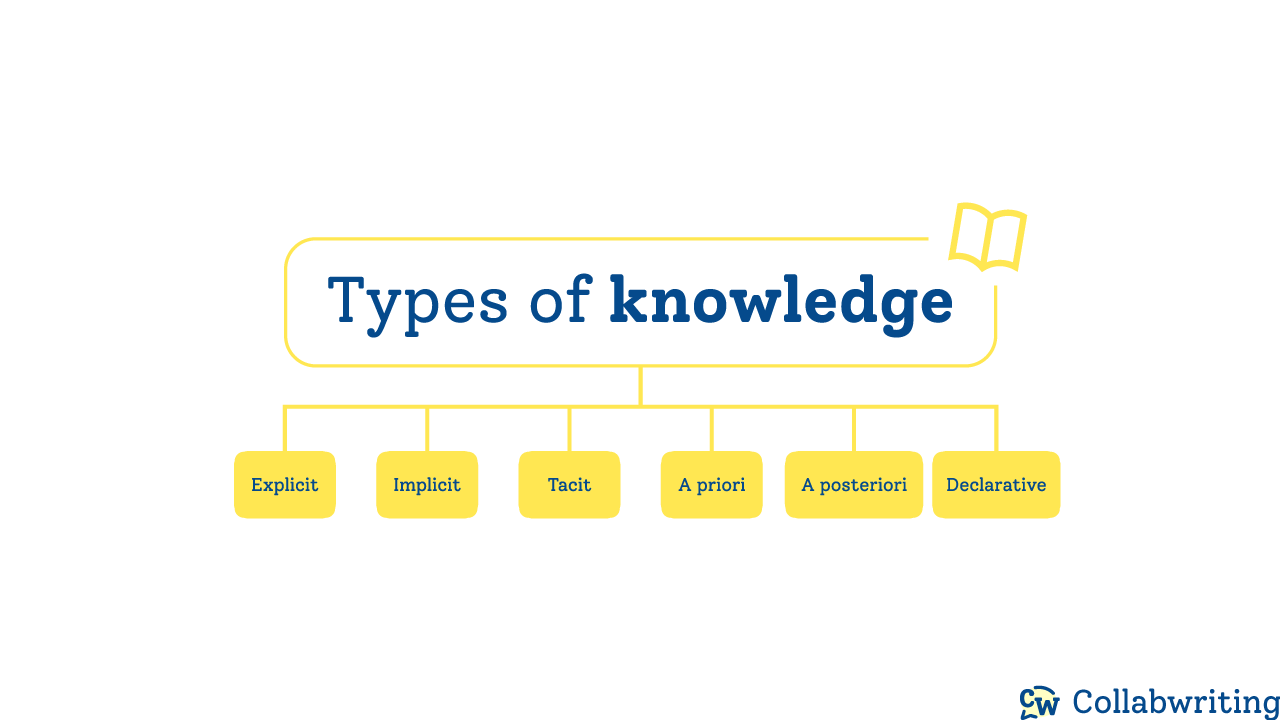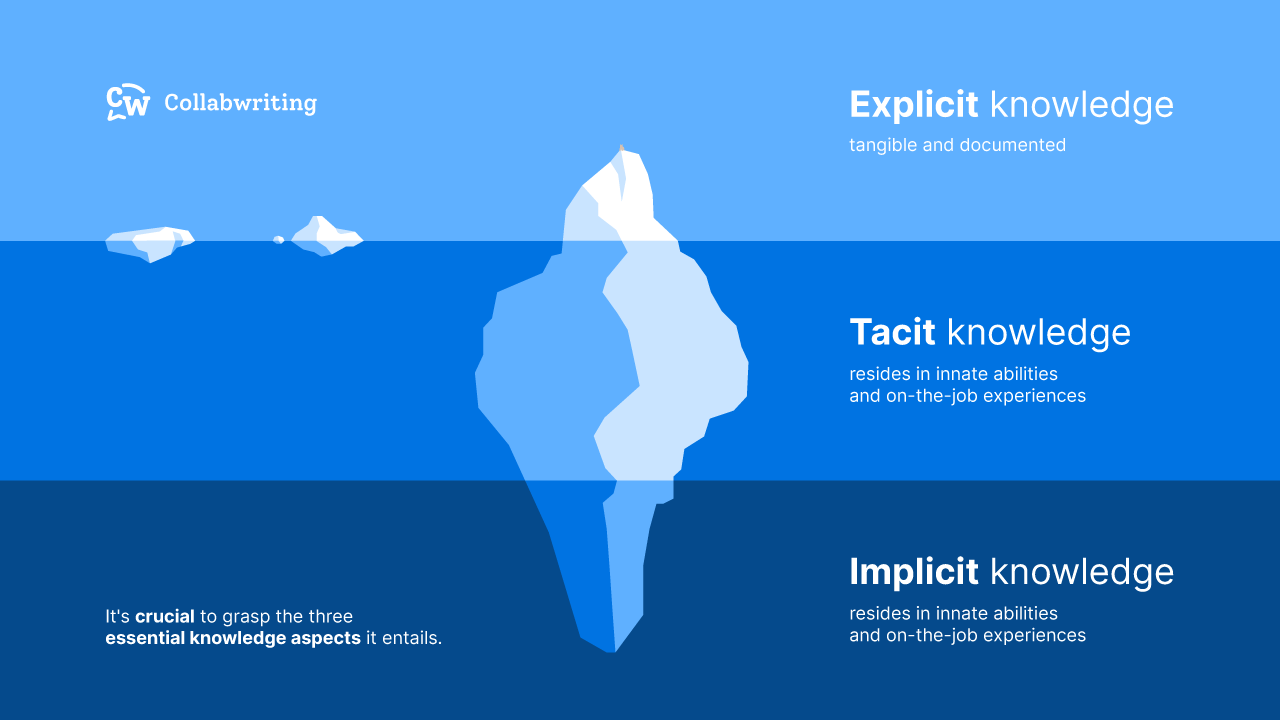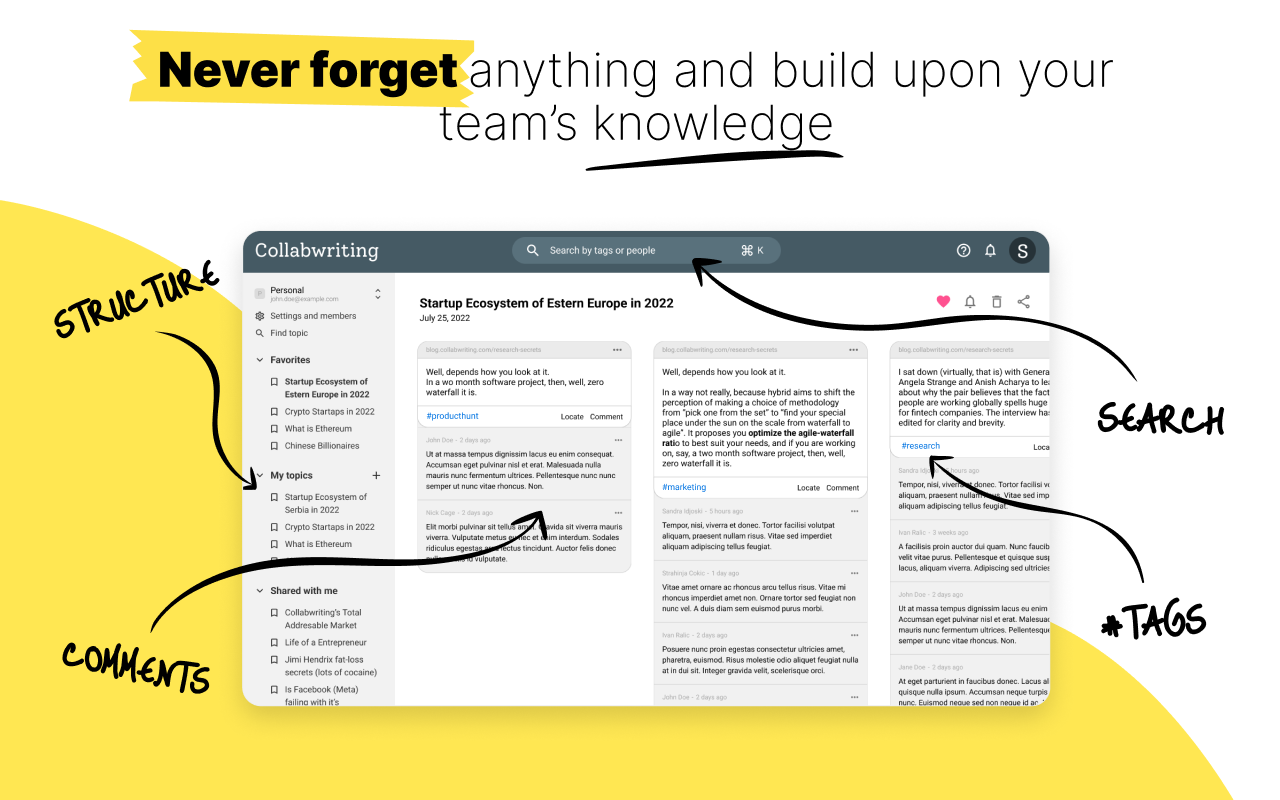As you start exploring knowledge management, you'll soon find yourself surrounded by a wealth of literature dating back to the early ‘90s when the concept first emerged. You'll discover terms like implicit, tacit, and explicit knowledge along the way.
To create a successful knowledge strategy for your team, it's important to understand these types of knowledge and how each contributes to your company's success.
However, knowing about explicit knowledge is key as it’s a fundamental type of knowledge that you can easily capture and share to boost your team's performance.
A short breakdown - 3 types of knowledge
To build an effective knowledge-sharing and management strategy for your company, start by exploring the various types of knowledge.

Although there are seven types, three ones stand out:
Explicit knowledge
Explicit knowledge, also called expressible knowledge, refers to information that can be written down, stored, and shared. It can be easily shared with customers or employees within an organization.
This knowledge is a helpful resource for others and can be documented in different ways, like knowledge bases, manuals, books, or videos.
For instance, a market research report that outlines trends, consumer behavior, and competitive analysis that can help you spot new opportunities is a great example of explicit knowledge.
Implicit knowledge
Implicit knowledge is putting explicit knowledge into practice. You probably see it happening in your organization all the time.
For example, when you ask a colleague how to do something, they might talk you through different ways to tackle the task and what results each approach might bring. It's their know-how guiding the discussion.
Also, think about skills and tricks that people pick up and can use in different jobs – that's another form of implicit knowledge.
Tacit knowledge
Tacit knowledge is the kind of knowledge we gain through personal experience and situations. It's what we know but find challenging to express or put into words.
Consider learning how to play a musical instrument. You might have the sheet music, but the finesse and timing come from practice and feeling the rhythm.
In the workplace, tacit knowledge is applying know-how specific to your company. Take a customer service representative who not only knows the company policies but also understands how to handle tricky situations based on their experience dealing with customers.

Explicit knowledge - The benefits
You might be asking why it's necessary to document and share explicit knowledge. Well, here are a couple of important reasons:
Empower your team with an internal knowledge base
Building an internal knowledge base filled with information about your organization, products, and services, and making it easily available to your employees, can benefit your business in numerous ways.
New hires can quickly grasp your company's operations and responsibilities while existing staff can improve their expertise and abilities.
Having internal documentation makes it easier to understand the current status of your company, including ongoing projects. Plus, it allows employees to access any information or resources they need to provide efficient service and make quick, smart decisions for the organization.
When employees can access a company's documented explicit knowledge, like customer data or industry reports, it helps them solve problems or make decisions in their work more confidently and efficiently.
Moreover, this saves time for both parties.
American workers waste 5.3 hours weekly searching for or recreating existing information.
Improves communication & customer service
Documenting explicit knowledge makes communication smoother among employees. It ensures everyone is on the same page, which helps provide better customer service.
With easy access to information, the support team can assist buyers more efficiently without always needing senior guidance. This means they can explain things clearly and get things done faster.
Avoid mistakes and improve reliability
By documenting your policies and procedures as explicit knowledge, you help your team avoid mistakes and ensure clear communication. Employees can refer to the documentation when completing tasks or assisting customers, ensuring they follow the correct procedures and do their work accurately.
Effortlessly track progress and avoid duplicates
By organizing explicit knowledge in your company's branded knowledge base, you can effectively track the progress of various projects and tasks. This ensures that solutions achieved within the organization are documented and easily accessible for future reference.
Employees can benefit from learning from past successes rather than starting from scratch every time. This not only saves time but also avoids duplicating tasks within your team.
Prevent knowledge loss
You can protect your company from significant knowledge loss by storing explicit knowledge.
How does it work?
When a key team member leaves, they might take critical knowledge with them, leaving a gap. But if you have that knowledge documented, you prevent this gap and ensure no one can replicate it using other methods.
Better product development and procedures
One of the key benefits of explicit knowledge is its ability to create standardized methods and procedures, enabling your organization to achieve outstanding results.
By establishing a system to capture, store, organize, and share your company's collective knowledge, you can generate new ideas, leading to exponential business growth over time.
Explicit knowledge - examples
- How-to guides
- Onboarding materials
- Employee handbooks
- Guidelines for content creation
- Marketing research reports
- Customer feedback
- Financial statements

Collabwriting - Shareable Notes on Web Pages and PDFs
Collabwriting allows you to gather all your online sources in one place. Just highlight, save, and collaborate with anyone on any content you find online.
Here's how to capture, store & share explicit knowledge
Capturing, storing, and sharing explicit knowledge can be beneficial for your company's growth. There are several good reasons to do it.
Let's explore how you can make it happen:
Capture
- Find what's important to know in your organization
- Try different ways such as writing documents, making manuals, or using tools to capture this knowledge
- Motivate employees to share what they know through written guides, videos, or training sessions
Identify knowledge gaps by asking employees and checking customer feedback. Also, consider how well teams perform and if they need more information.
Store
- Choose a centralized place or platform to store knowledge
- Organize knowledge in a structured way so it's easy to find
- Keep track of changes and updates over time
- Make sure your knowledge is up-to-date
Share
- Foster a culture of knowledge sharing within your organization
- Ensure easy access to stored knowledge through user-friendly platforms
- Encourage collaboration and feedback to improve and update shared knowledge continuously
Summing up
Capturing and improving your company’s explicit knowledge can be tough. It requires a solid plan, ongoing effort, and a reliable system for managing information.
But once you get it right, your organization can tap into its full potential and drive real growth. Your internal knowledge is what holds your company together, so it's crucial to make the most of it rather than letting it slip away.
It's time to make your knowledge work for you.




![Best Research Collaboration Tools in 2025: Zotero, Paperpile & Collabwriting [Compared]](/content/images/2025/07/image--7--1.png)








